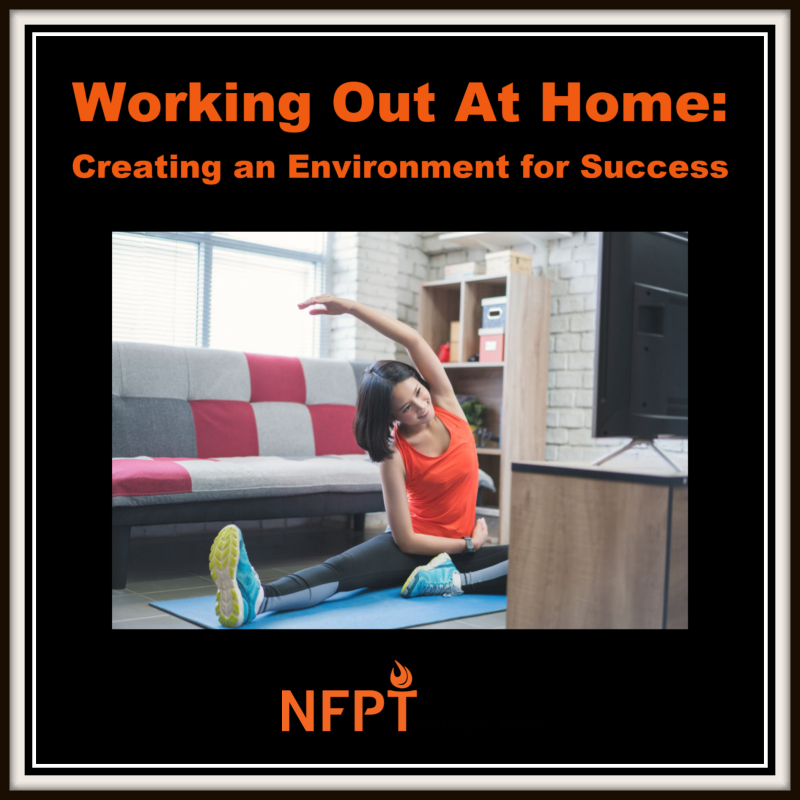
With gym closures and social distancing protocols in place nationwide, worldwide, working out at home has become the only solution. Virtual fitness classes and living room push-ups have become the norm, at-least temporarily. But what’s really different between exercise at the gym and exercise at home? Gravity is the same, dumbbells can be purchased by anyone, and yoga teachers are easy to access online (or in your home sans-pandemic). According to a number of theories from the school of behavioral economics and habit change, there is much more than just logistics at play; environment and the associated qualities of that environment holds a powerful influence over behavior.
There are many interesting behavioral concepts and perceptual fallacies that guide the norms we rely on that may seem counter-intuitive. How they differ in various settings like the gym, our homes, a fancy hotel, or an airport is one of the most important factors to consider, especially when resistance is encountered.
Let’s discuss some tangible and actionable ideas to help promote home fitness and nudge people toward healthy decisions. There are two theories based on behavioral research that shed light on how environment influences motivation and choice.
Broken Windows Theory
Introduced in a 1982 article by social scientist James Q. Wilson, the broken windows theory suggests that an individual’s acute physical environment dictates their behavior in a number of ways. For example, imagine you are walking through a neighborhood full of old, abandoned buildings with broken windows, and trash strewn across the sidewalks. In this setting, it wouldn’t take much moral energy to throw a rock through a window. Now, imagine you are in a nice area of town, where people spend time cleaning windows, trimming shrubs, and picking up trash. We are expected to act differently here.
In a few unique social experiments, psychologist Philip Zimbardo attempted to prove what essentially became the broken windows theory. The famed ‘Stanford Prison Experiment’ professor abandoned two cars with their hoods up. One in Bronx, NY, the other in Palo Alto, CA. The car in the Bronx was completely stripped and vandalized within 48 hours. In the late 60s when this experiment took place, this wasn’t very surprising for that particular part of the Bronx. However, the car in Palo Alto, a more “reputable” city went untouched for a week. That is, until Zimbardo purposely broke the car’s windows. Within two days the Palo Alto car resembled the Bronx car. All it took was altering the car’s appearance (or environment).
Perhaps the difficulty of home workouts has much less to do with equipment and amenities than it does with norms, the simple expectation that the gym is for working out…and home is for everything else.
Humans rely on the categorization of things and ideas in order to handle the infinite amount of stimuli that we encounter daily. This is where habit not only comes in handy but is an essential tool for survival. When we go to the gym we anticipate the workout on the way over and engage in exercise without too much hesitation once we arrive. That’s what we’re there for.
But, home is where we throw our feet up and specifically seek to avoid the strenuous activity associated with working out. Just the simple reality of being at home evokes associations and certain actions that for most people have historically had nothing to do with exercise.
To sum up the concept, habits aren’t only triggered by feelings or time of day, but by many things including ingrained associations, atmosphere, and environment. It may be very difficult for someone who has always worked out in a gym to transition to a home workout where they may never have done so.
The Price Of A Beer
Rational economic theory suggests that you should pay as much for any good or service as you think it’s worth. Recent Nobel Prize winner Richard Thaler proved through his ground-breaking research that we make anything BUT rational decisions when it comes to purchases. He illustrated that even just the concept or thought of a certain “environment” will change the expectation of prices or perceived value. In some of his early research he presented a thought experiment to a number of educated professionals:
Imagine you are on a beach with a friend and nothing sounds better to you than a cold beer. Your friend is getting up to go purchase some drinks. They ask ‘what is the maximum amount you want me to spend on a ‘Brand A’ beer from the convenience store?’. The median answer in Thaler’s research was $1.50. Now imagine that same scenario but your friend asks ‘what is the maximum amount you want me to spend on a ‘Brand A’ beer from the fancy beach hotel?’. Rationally it should be the same amount, but the median in this case was $2.65.
We have expectations for certain atmospheres and environments that create hard to change associations. This is why we are ok paying a different price for the same exact beer if it comes from a convenience store or a fancy hotel, even if we don’t actually make the purchase, or experience the atmosphere, ourselves.
When we’re in an airport, although a place where we theoretically have extra time to exercise, it’s probably not the right environment to provide the necessary motivation to do our squats and push-ups. Not to mention, most people would feel silly exercising in the middle of a seating area.
How does this concept apply to home workouts? In the research example above, the different price the subjects were willing to pay for the exact same product proves that environment alone changes expectations. The thought of a certain location, like your home, evokes associations and certain actions that for most people have historically had nothing to do with exercise making it more difficult to transfer the same set of disciplined behaviors from the gym setting to the home setting.
Supporting Clients Who Resist the Home Workout
For some, a home workout is preferred, because of the convenience or simply due to the absence of an audience. But for others the constant distractions, duties, and associations with the home might prove a hindrance for a good workout. The key to battle the logistical and perceptual barriers to fitness in the age of the Covid crisis is to remember that environment matters.
According to James Clear, in his best selling book Atomic Habits, ideal behavior change must be Obvious, Attractive, Easy, and Satisfying. A perspective echoed by The Power Of Habit author Charles Duhigg, and Richard Thaler himself, co-author of Nudge and the previously mentioned Nobel laureate.
What can we do to make fitness more attainable and accessible at home?
Equipment. Success first relies on necessary tools being easy to access. Simple solution here…get fitness equipment at home. Suspension Straps, mini loops, resistance bands, dumbells, or even just an exercise mat. Don’t forget that novelty can be an exciting incentive for many reasons, so interesting and unique functional training tools are a great idea to start.
Designated Space. Define a space in the home that might not only be convenient for exercise, but has been mandated as an area available for fitness activities. Any 6’ X 6’ space can technically be used for a workout, but to set an intention for a space will help to set the precedent for the behavior expected there. Perhaps a part of the yard, garage, or a spare bedroom in order to avoid the distractions of the TV and the associations with the kitchen or office. If possible, a space where fitness equipment can be kept accessible would be of benefit.
Guidance. Professional guidance not only provides safe and efficient workouts, but it helps to draw a clear line between workout time, and NOT workout time. This could be in the form of a personal trainer who comes to your home, a virtual trainer (which is becoming more popular in the wake of the Covid crisis).
Support. What more satisfying aspect is there for most exercisers than the camaraderie they get from their gym friends or group exercise cohorts? Perhaps the most trying part of being stuck at home is the lack of connection to our various communities. We can take advantage of the many opportunities and platforms for virtual engagement by setting up group workouts and attending our favorite classes on our laptop or phone. If that’s not a client’s typical source of motivation, consider offering accountability coaching, or encouraging fitness enthusiasts to hook up with a buddy who can follow a similar program on a similar schedule to check in with for motivation and accountability.
As much as we can program digital exercise plans, share recipes for healthy meals, and post our workouts on social media, we still need to account for human behavior. Having the tools and information for someone to act on doesn’t necessarily mean they have the mindset to do it. Help yourself, your clients, and your friends succeed during these crazy times by creating the space for exercise at home, and the intention that goes with it.

About the author: Andrew is a recognized speaker in the fitness industry, master trainer, and serves as Director of Education for AktivSolutions. He is a NASM and NFPT Certified Personal Trainer, creator of the MostFit line of fitness equipment, and has developed comprehensive fitness and wellness initiatives for health club & workplace wellness programs. Andrew’s passion centers around user engagement and human behavior. Checkout his website .







